Spending Time In Srinagar
A brittle red-brown Chinar leaf hidden in the yellowing pages of an old journal brought an avalanche of fond memories of a town that despite being mired in terrorism had managed to enchant me. Seventeen years later, Srinagar still holds a special place in my heart.
Often called ‘Paradise on Earth‘, Srinagar, a name contorted centuries ago in local dialect from original ‘Surya Nagar’ was summer escape of Mughals and continues to be the summer capital of the state of Jammu-Kashmir. Nestled in picturesque Kashmir valley along the banks of river Jhelum, the town dates back to 12th century and finds mention in ancient Chinese records of Tang Dynasty as Siri-Nagar.
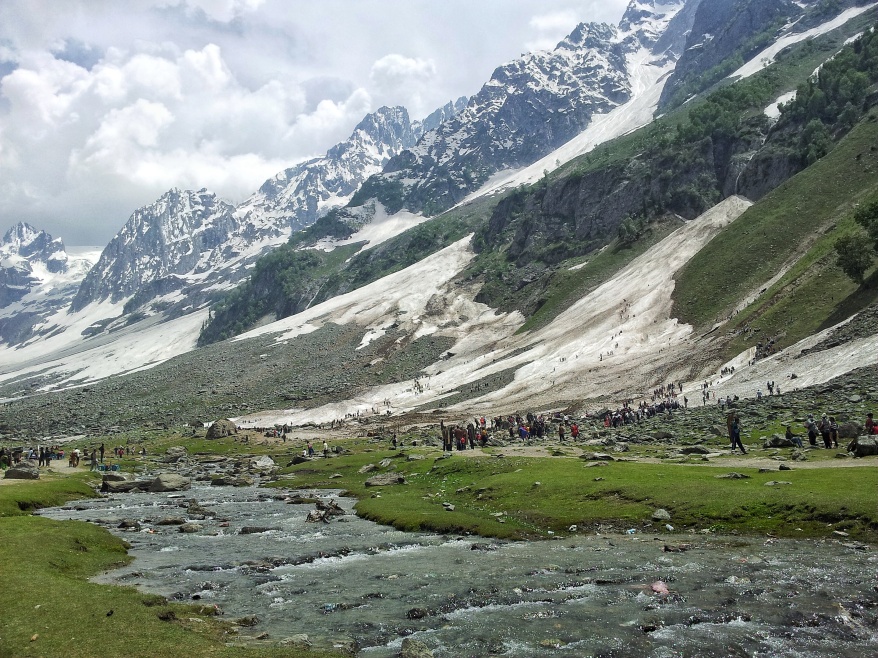
Kashmir valley picture by Mayuri Patel. Read her post on Exploring Kashmir.
The towering pristine snow-capped Himalayas, flaming red Chinars, delicate pinks of almond blossom, the purples of saffron flowers, the vast blue placidity of Dal broken by blooming lotuses and gently bobbing exquisitely carved houseboats and shikaras ….many a yesteryear films shot extensively in those salubrious climes have very well depicted the ethereal beauty of this valley town.
Indeed Srinagar is a mesmerizing concoction of all the colors in rainbow.
**There is no threat to tourists now and Kashmir must be on your to-do list at least once.**
But the Kashmir that I spent early days of my marriage in, had also the shades of gray….
November 1999
Kargil war was a fresh wound and memory. When I first stepped into the northern most state of country an ominous silence and lack of general humdrum of a bustling city had greeted me as I drove from Airport to Jammu Army transit camp in November 1999. Heavily armed men in olive greens manned the entrance gates of the military establishment, thoroughly checking identities of every vehicle waiting to enter through. The permitted vehicles were greeted with a crisp ‘Jai Hind Saab’.
The defense establishments are usually on high alert especially in areas prone to terrorist activities but the tension in air was palpable even to an untrained eye of newly married civilian like me hailing from an almost peaceful town where burglary and local mob skirmishes were the only concern. What made me nervous was heightened sense of alertness in my husband. I remember, after a silent dinner at mess, I had wanted to know why everyone around us seemed so on tenterhooks. It was then I realized what the days ahead as an armed forces spouse might entail…
A day before when we landed in Jammu, the army establishment at Srinagar, Badami Bagh Cantonment, had come under attack by terrorists. Unarmed defense personnel waiting to board a bus were shot down in cold blood. Jammu transit camp hence was naturally anticipating trouble.
Sobered and scared, I reached Srinagar airport the next day to be welcomed in the folds of Indian Air Force where my husband was stationed. The chances of exploring the once-upon-a-time glorious Srinagar seemed bleak in aftermath of such a depressing incident.
The air force station however, surrounded by tall conifers, wild rose bushes and almond trees, was like a cocoon; less accessible to terror mongers. I felt much at ease and protected.
When you begin to inhabit a place, it is the connect or disconnect you feel with people first that translates into love or hate relationship with it. And fellow officers made damn sure that I connect with life in Air Force station pronto!
My welcome to the Srinagar Air Force Station began with a huge prank(and that is another interesting account of life amidst men in uniform) with pranksters becoming more like an extended family later.
With ice broken began the cycle of unending, unannounced and unrestrained banter, more bonding with friends over late dinners at home and plans to explore town.
Snowfall
First week of December brought fluffy snowflakes dropping down from heavens above and instant drop in temperatures. I realized that snowfall had begun when I woke to loud banging on our house door from fellow officers. We scrambled outside to witness the first snowfall of my life. Soon we all were walking in ankle-deep snow and of course nobody wanted to go to office…obviously they couldn’t fly in that weather. The boss was roped in and the day officially declared off for the pilots…. ‘snow-day’.
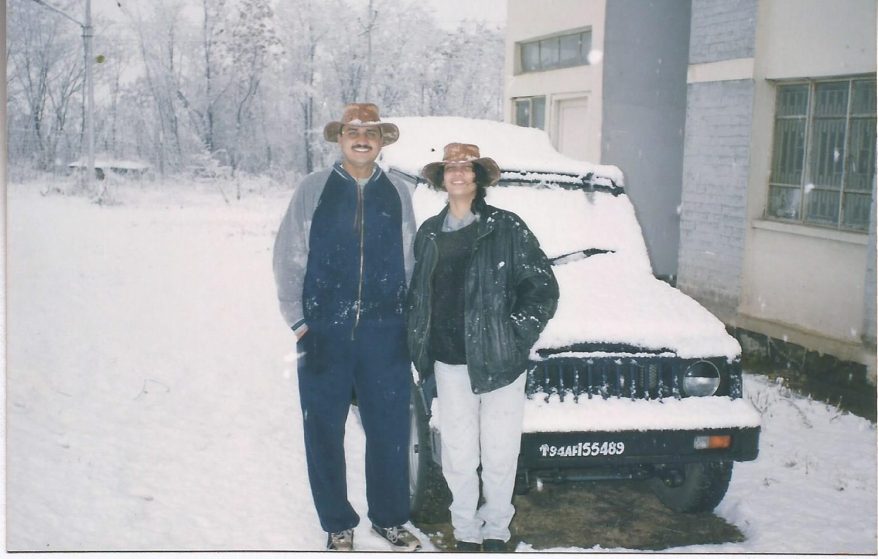
My first snowfall
Men who flew such mean machines and dealt a powerful blow to enemies in Kargil war, played like little kids in season’s first snowfall!
Tip:
1. The neighboring town, Gulmarg, has gentle slopes for skiing enthusiasts and is best visited in winters after the snowfall.

Plodding through the knee-deep snow at Gulmarg
2. Not the skiing type? You can still have those snow ball fights and make a snowman. A winter visit to Srinagar and around is a fun vacation.
Chillblains!
When feet and hands are exposed to wet and cold conditions for a longer period of time, they swell up, itch and if you scratch continuously the skin develops blisters!!
And I soon learnt this after a month of snowfall!
Once the excitement of first snowfall had subsided I got back to daily routine. The regular house chores meant exposure to extreme cold tap water and soon my toes and fingers turned red, puffed and itchy. A proper medical attention did relieve the pain. The quick-fix way of warming my toes from electric heater had done more harm to my wet-cold feet.
TIP:
1. Trick is to cover exposed parts of body with woolen clothing to let it warm gradually.
2. Apply body cream gently on affected toes and fingers.
Imagine how our soldiers fight the forces of nature at Siachen!
Dal Lake
By the time weather opened up and the white sheet that had covered every inch began to melt I had spent four months in company of the young pilots occasionally hosting them from my kitchen(and in process improving my cooking skills) and listening to their jokes, secret crushes, adventures and the war stories. I was officially a part of their circle.
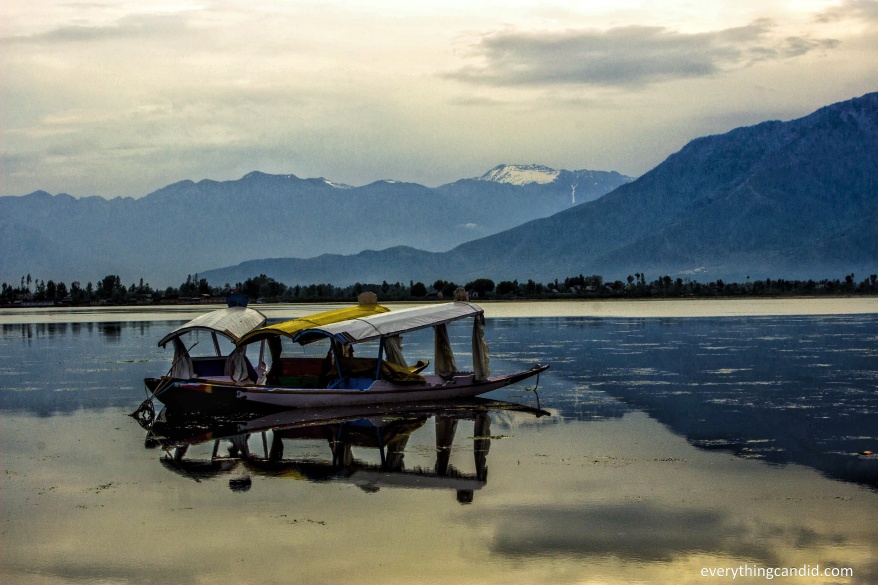
Shikaras on Dal Lake. This picture has been shared by Himanshu Barsainya. Read his Reasons To Travel To Kashmir .
Young blood that we were, all of us were yearning to venture out of the confines of Air Force Station with sun smiling down after months of freezing cold. Since permissions for venturing out solo or past the day light hours in civilian areas beyond military establishments had been revoked after militant attacks, we visited the town in small groups always.
One such visit saw us all at the shores of Dal Lake.
It was the time when armed forces personnel and their families were hot targets of militants. We tried to be as inconspicuous as possible. While the men in the group had no Kashmiri attire, we women wore a salwar kameez with typical Kashmiri embroidery, covered our heads with dupatta and wore no bindi on our foreheads. The typical fauji haircut and firm gait however almost always gave men away.
The men rowing ‘shikara’, which are small flat-ish boats to travel across the Dal lake, for tourists instantly recognized us as outsiders and a fauji crowd! While we tried to hire a couple of those flat narrow boats, I heard one jovial old man say…
‘Aur char gaya hai Army ka abhi’ (Four more from Army have gone for ride just now)
That… was the end of discussion…there was no scope to negotiate the price because we did not want any unwanted attention to our little unarmed unprotected group.
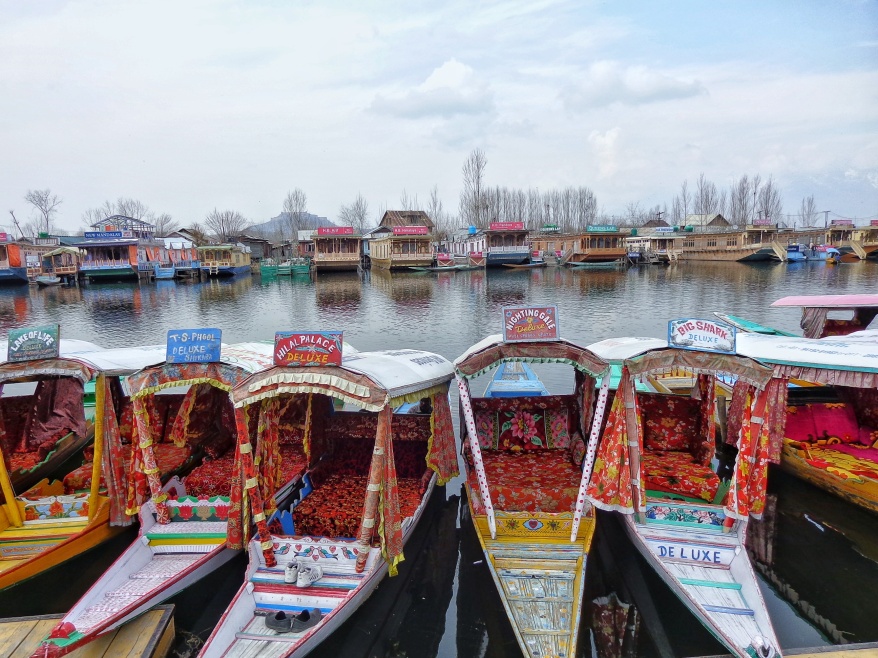
Shikaras and houseboats at Dal lake. Pic by Deepak Dua
I never could stay in houseboats…just saw them from a distance. I would very much like to experience the luxurious stay some day… but those were not happy times. Sadly we stayed away from narrow waterways around houseboats, from floating market at Dal and where ever there was scope of hostility.
Tip:
-
Floating markets of Dal lake are a unique feature. Kashmiris sell almost everything on those narrow flat boats and houseboats from spices to vegetables and fruits to craft items and packaged beverages and snacks.
-
The market is a must see…so I have heard. Check it out when you visit next and stay in a houseboat.
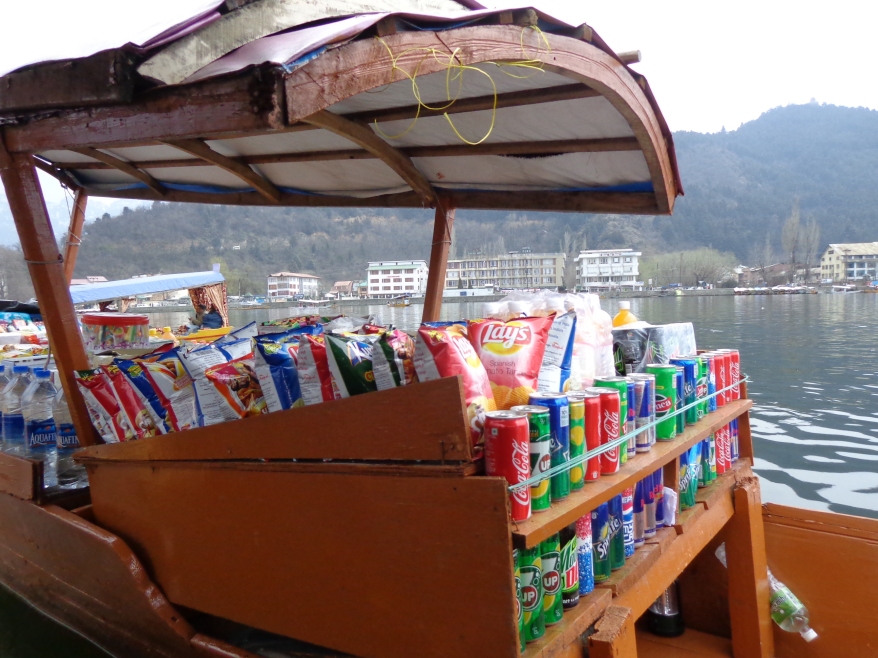
One of the Shikara stocked with snack items. Image: Deepak Dua
Mughal Gardens
Our boat did however circle the Char Chinar, a small island in Dal. The island is so named for presence of four tall majestic Chinar trees or boonyi in Kashmiri. The Chinar tree that derives its name from fiery red shades that the leaves acquire in autumn has become an identity of sorts of Kashmir valley. Incessant felling however has brought the tree on verge of being wiped away.

Char Chinar. Pic by Deepak Dua
The water tank at Char Chinar was constructed by Murad, Mughal Emperor Aurangzeb’s brother. Dal Lake is lined with Mughal Gardens. Chashme Shahi, Nishat Bag, Shalimar Bag, Pari Mahal and Achabal being the popular ones.
700 gardens were laid out in Kashmir influenced by Persian style during the reign of Mughals.
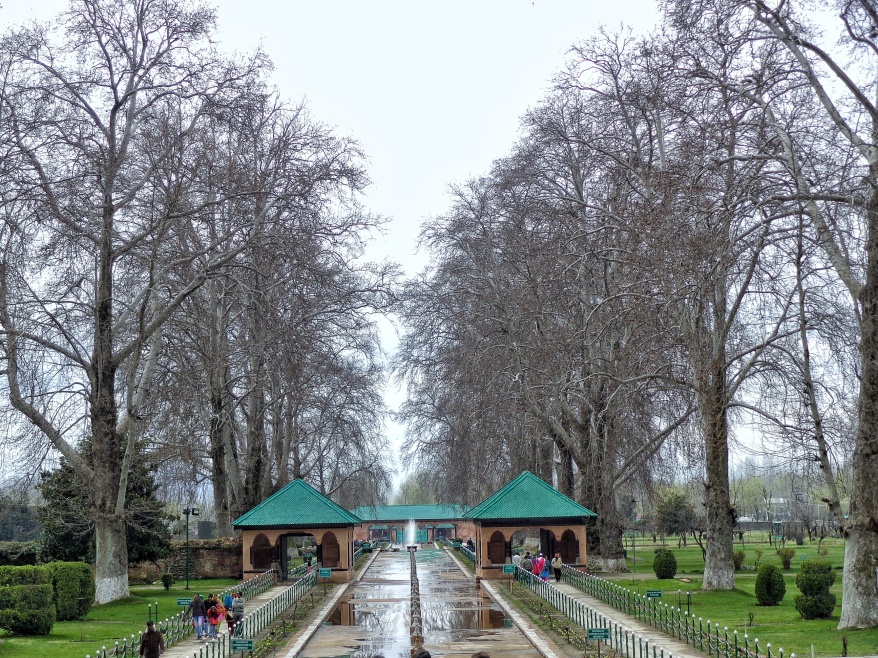
Mughal Garden At Srinagar. Picture from personal collection of Mr Deepak Dua, journalist & Film reviewer. Read his reviews.
What I remember of these gardens with distinct red stone pavilions, terraces, baradari, fountains with water cascading into narrow ornate canals of water dividing the gardens into four quadrants; the Persian concept of ‘chahar bagh’, are the enormous size of Dahlias in every imaginable color, the tall Chinars and soft green grass carpeting the spaces.
I collected many fallen down Chinar leaves and a green walnut! Having never seen a raw walnut I picked the fallen fruit only to realize later how acidic its sap was when the stain from the raw fruit left the fabric of kerchief threadbare!

Mughal garden fountains. Pic by Deepak Dua
While Shalimar Bagh, that was also used by Emperor to hold court, is more architecturally grander and more embellished, Chashme Shahi is known for a natural spring, water of which supposedly had healing properties. The emperor seemed to have visited the spring and garden for many years to recuperate from his ailments.
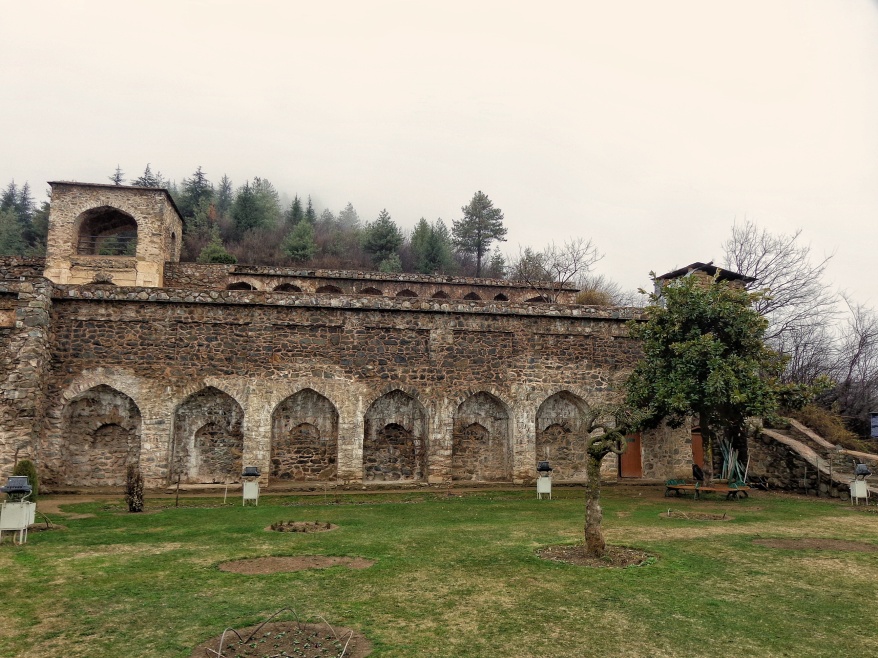
A part of Pari Mahal. Pic by Deepak Dua
Pari Mahal which besides a garden also has a palace with terraces overlooking the valley and the most picturesque Golf course of Asia, the Royal Spirngs Golf Course, was occupied by BSF and army then and hence inaccessible to tourists. Permissions from army had to be procured to visit which was, for security reasons, mostly denied. With similar security clearances, we could however make a short trip to the gardens and sand bag lined terraces. All I remember is men in uniform keeping an eye on trouble from the high perch.
Now however Pari Mahal is open to tourists. A new addition that opened up for tourists at Srinagar is the Tulip Garden.
Town Center
The historic Lal Chowk and clock tower areas were heavily guarded areas. I could never explore the area…just heard stories from husband and his friends when they narrowly escaped getting caught in a cross fire situation.
I don’t remember much of Shankaracharya temple. Perhaps because it was in much neglected state then. I did climb up to visit though. Even Martandya Temple, one of the ancient temples dedicated to Sun was in much ruins and neglected in those days and I remember seeing it from a bus on way to Gulmarg/Pehalgam.
Local Pleasures
Kahwa, Kesar and Riyaz
Kahwa and kesar was introduced to me by our part-time domestic help, a young 20-year-old village boy Riyaz. He would bring a small amount in a bag from village and taught me how to get it right. He would occasionally bring a few sprigs of authentic ‘kesar’ from his village too. The pure saffron or kesar sold in 10 gram boxes doesn’t come cheap in rest of the country. In Srinagar back then however, I used kesar in every sweet that I made and realized only later when I left Srinagar of its exorbitant cost…
Kahwa is local green tea of Kashmir that is infused with saffron, cardamom, dalchini and thin slices of almonds.
Tip:
1. Buy kesar and kahwa from Kashmir Government Emporium.
Once there was a massive power cut that went on for four days during heavy snowfall. Riyaz did not turn up for work. The electric supply resumed but Riyaz failed to come for work for another few days. When I had given up hope and assumed he would not return, Riyaz showed up at my doorstep…. sad and scared.
Riyaz’s village was raided by militants during that week. His friend was shot down by the terrorists. That day Riyaz who normally did not eat or drink at my home because I was a Hindu, sat and cried pouring his heart out to me.
Bakeries
Kashmiris bake a wide variety of breads to eat at various times of the day. The bakeries start operating from quite early in morning. A crisp and flaky roundish bun or bread sprinkled with til or sesame and khuskhus, poppy seeds is called tsot. Baqerkhani and lavas are different breads. Kulcha which is more like flat bread or chapati in size and shape is usually eaten during meal time with gravies.
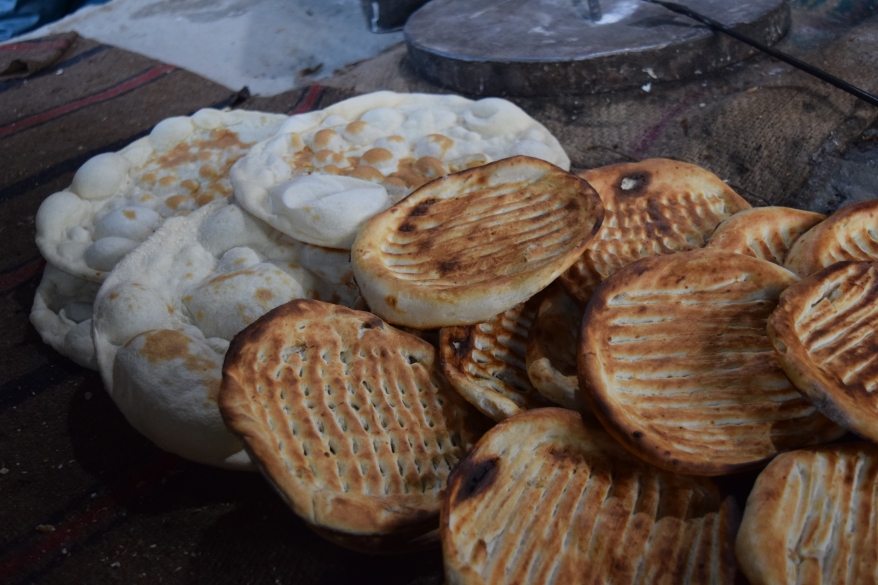
Various breads. Image by Sindhu Murthy. Read her work here.
Tip:
1. Try fresh and hot from oven breads with kahwa.
While I did not eat the different breads but I remember, the cakes and pastries of Jan Bakers. Every visit to town meant a quick trip to Jan bakery especially for Black Forest Pastry.
Kashmiri Crafts
Kashmiris are skilled craftsmen. One look at intricate carvings of houseboats is enough proof. Walnut wood is preferred material for furniture and decor items like lamp stands, sofas and settees, stand alone panels. Cricket bats made from Willow wood are much sought by the sportsmen. Kashmiris make a lot of papier mache decorative stuff from wall plates to napkin holders, bells and balls etc. Metal carving, cane craft, carpet weaving, and embroidery are other popular crafts of Kashmir valley.
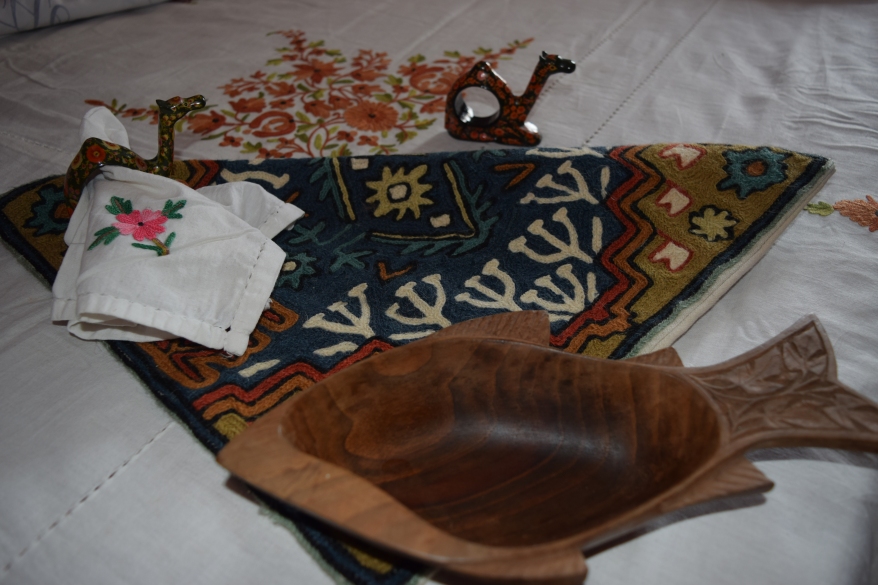
Some of the things I still hold on to…. papier mache napkin-holders, cushions, wood bowl, bed-cover, tablecloth
Having lived in Srinagar for almost two years, I shopped to my heart’s content. From embroidered bed-sheets, table-cloths, cushions, pheren which is a warm loose long kaftan for both men and women, lamp stands, wood utensils, papeir-mache trinkets…I bought them all. Some things still survive the numerous postings across the country.
Tip:
1. These handicrafts are best bought from the Kashmir emporium.
2. A popular seller for hand embroidered silks, cotton material, jackets and Chinon Sarees etc was and I think still is G M Shah.
3. Don’t forget to buy dry-fruits especially ‘kagdi’ walnuts and almonds. The shell of these is thinner and edible part is plumper.
It was almost time for us to be posted out. While my husband had timed three and half years in the valley, I had spent almost a year and half in terror stricken beautiful city and then…
Terror came knocking closer to home…
January 2001, while I went about my routine, a militant attack was thwarted at the civil airport. The civil airport terminal entrance and the entrance to Air Force Station at Srinagar were adjacent to each other then with just barbed wire fencing separating the civil and defense area. The militants aimed to storm through civil terminal to enter the defense establishment. The firing that ensued claimed the lives of police woman constable and guard. The militants were shot down and prevented from entering the terminal.
It was only in the evening when the situation was well under control that the families of air warriors realized how close we had come under attack.
By June 2001 we left Srinagar for next posting. It was relieving to move to a much peaceful station next. But I never fell in love with any other place as much as I did with Srinagar. I will always have a special place for the town and like a lost lover always yearn for peace so that I may visit it again and fall in love over and over again.
Around Srinagar
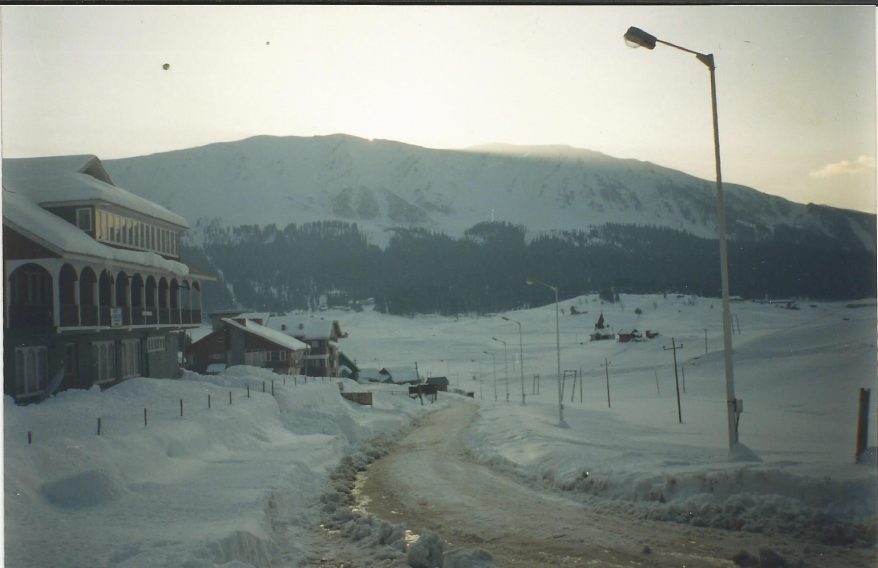
Gulmarg
Gulmarg, Pehalgam, Sonmarg each is about 2 to 3 hrs from Srinagar accessible by road. Taxi and bus services are regular.
How to reach:
- Srinagar is an International Airport now well-connected to New Delhi, Mumbai, Leh, Jammu and Chandigarh. Regular domestic and some international flights operate from Srinagar.
- National Highways are easy options for road travel.
Where to Stay:
- The Lalit Grand Palace is best for the luxurious stay
- Houseboats are quite luxurious and comfortable as well and perfect for enjoying nature and local life.
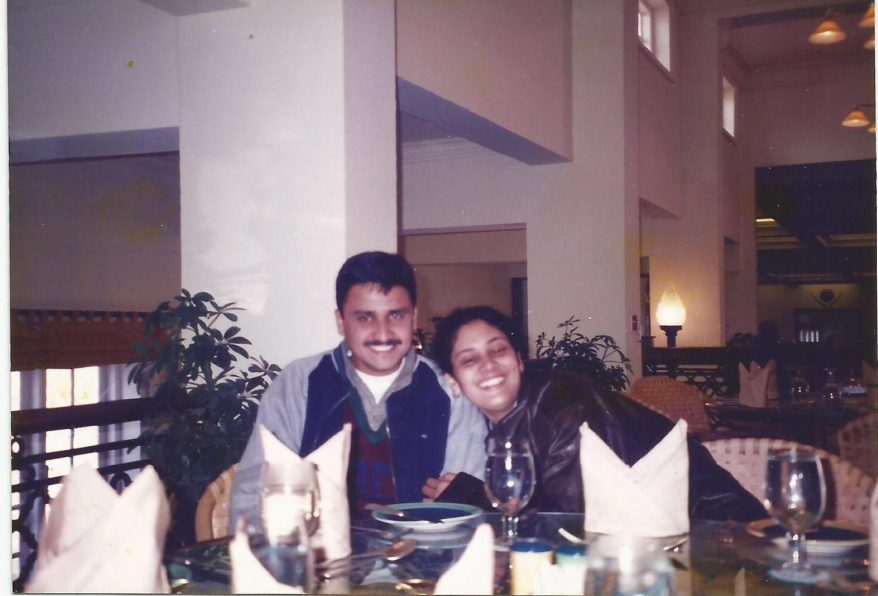
Early meals at Grand Palace
Please shower your love…leave a comment… and follow me at Twitter, Instagram, Facebook, Pinterest
Most of the images except those featuring me have been sourced from friends and fellow bloggers Deepak Dua, Mayuri Patel, Himanshu Barsainya, Sindhu Murti and Pooja Ghelani. These pictures are of recent years and prove that it is safe for tourists to visit Srinagar and Kashmir valley. I am grateful to these friends for helping me create a nostalgic post.


It was really amazing to go through this posts, knowledge enriched about Srinagar. Welcome with prank is common in Air force is a tradition…so far i know.
LikeLiked by 1 person
Thank you Jyotirmay. Yes it is a tradition to prank a new bride 😁
LikeLiked by 1 person
Thank you Jyotirmay. Yes it’s a tradition to prank the newly wed 😁
LikeLiked by 1 person
Super nice. Hope to visit soon
LikeLiked by 1 person
Thank you so much Shrinidhi for reading through. You definitely must visit Kashmir once.
LikeLike
very nicely written and cool pictures!
LikeLike
Thank you. Pictures have been contributed by blogger friends.
LikeLike
Amazing and nostalgic. Since my first visit to Kashmir, which was a Bike ride with my daughter and was curtailed due to an accident en route, I have fallen in love with Kashmir and keep on looking for an excuse to visit Kashmir. I have travelled to even the remotest areas of Kashmir and they are the benchmarks for beautiful places. I have jotted down my memoirs here. Do read and comment whenever you have time.
https://www.parveendua.com/2018/11/kashmir-bungus-lolab1.html
LikeLiked by 1 person
Thank you Parveen. Loved your pictures and post. That is the real Kashmir. thanks for sharing.
LikeLike
A comprehensive list for the travelers visiting Srinagar. Great post.
LikeLiked by 1 person
Thank you.
LikeLike
Beautiful write up. Took us through the Srinagar of late 90s.
LikeLike
Thank you Sudha. Glad you liked it.
LikeLike
I wish to visit Srinagar from a long time.. but because of its unstable conditions, it always becomes a second thought..
LikeLiked by 1 person
You must…it’s beautiful…I know the beauty is marred by continued unstable law and order condition but whenever possible you must do it and nearby areas.
LikeLike
What areas will be safer if I plan to travel there?
LikeLiked by 1 person
Gulmarg ,Sonmarg, Pehalgam and Srinagar all are good to visit.
LikeLike
Thankyou so much for your suggestions 😊
LikeLiked by 1 person
👍🙂 best wishes for your vacation
LikeLike
Beautiful Post. Best places to visit in Kashmir. I am also live in Kashmir.
LikeLiked by 1 person
Indeed Kashmir is ‘jannat’ if only terrorists stop making it hell
LikeLike
Very good article, thanks
LikeLiked by 1 person
Thank you
LikeLike